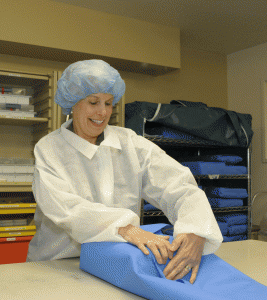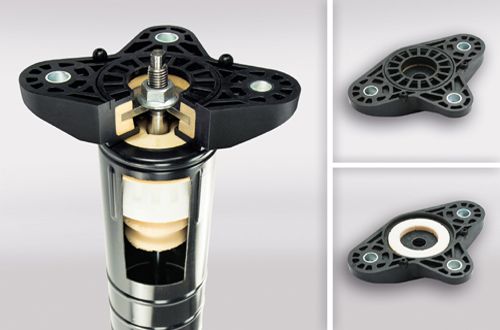
In 2005, California-based Catholic Healthcare West (CHW) became one of the first, if not the first, hospital group in the United States to stop using polyvinyl chloride (PVC) for intravenous (IV) bags, solutions, and tubing.
Today known as Dignity Health, the healthcare organization is a founding sponsor of the Healthier Hospitals Initiative and is leading in other sustainability efforts, including several involving plastics.
Last month. Dignity Health announced it will be the first health care system in the nation to begin using
pigment-free patient plastics in all of its hospitals and other care centers to reduce impact on the environment.
“We began our sustainability program formally in 1996,” says Sr. Mary Ellen Leciejewski, Dignity Health ecology program coordinator.
One of the initial drivers was a push from the employees. “A lot of them were doing recycling at home, and they wanted to bring these activities into the workplace,” she told Plastics Today in an interview. Another push came from a shareholder activism team. “We were asking companies to clean up their environmental act, and at the same time our house wasn’t in order.”
The third factor involved the sisters who brought hospitals together to form Catholic Healthcare West in 1986. “We all had phrases in our official documents that emphasized care for creation. All of this grabbed the attention of CHW, and it became a formal initiative.”
One of the first major moves was a decision to no longer use PVC for IV bags and tubing–a decision that predated by seven years a similar move announced this year by healthcare giants Kaiser Permanente (Oakland, CA) and Partners Healthcare (Boston).
“That wasn’t a difficult decision at all,” says Leciejewski. “It was a no brainer when we looked at it. We had our eyes opened up by Health Care Without Harm.” Twenty-eight organizations founded Health Care Without Harm in 1996 after the U.S. Environmental Protection Agency identified medical waste incineration as the leading source of dioxin. Most hospital incinerators have since closed.
The organization has this statement about di-2-ethylhexyl phthalate (DEHP) plasticizer used in PVC tubing on its Web site:
“DEHP can leach out from products like IV tubing, directly into the body of the patient. Medical associations and government agencies in several countries now acknowledge that there are risks, especially to the most vulnerable patients, and advocate replacing PVC and DEHP-containing products with alternatives.”
Dignity Health moved to polyolefin-based replacements supplied by B. Braun Medical (Bethlehem, PA), whose Web sites states that it “is the only manufacturer of a full line of basic IV solutions in PVC-free and DEHP-free containers.”
The replacements cost somewhat more, but the transition has been generally smooth.
“The only thing is that because there is no DEHP plasticizer, the products may not be quite as flexible, so you may have to handle them a little more gently,” says Leciejewski. “It was not a big change or a big deal. What was a big deal is that I knew in my heart that we were doing the right thing.” She said there were no alternative products for some applications.
There was no discernible change in patient health as a result of the change. “It could be one of those things like smoking where you really don’t know until 30 or 40 years down the line what the impact is. I wish we had that magic button where we could see that. But again, it’s first ‘do no harm’. If we know that DEHP is not going into patients, it can only be a good thing.”
There are no other specific types of plastics that Dignity Health is targeting for elimination or phase-out.
“There are so many plastics in hospitals. We’re trying to reduce our use of it. We’re going to reusables where we can. That’s a step up the ladder.” One example is a reusable sharps container called Bio Systems from Stericycle. With sterilization, they are being used 600 times at Dignity Health before they need to be taken out of service. Pharmaceutical containers are also being reused.
Each hospital in the system has an “eco contact” who keeps an eye out for possible problems. As a result, there is growing emphasis on reusable mugs made from stainless steel in place of polycarbonate bottles that contain bisphenol A (BPA).
Dignity Health operates 40 acute care hospitals and 150 clinics and ancillary care centers. Net operating revenues last year were $10.6 billion. Of the 55,000 employees, 10,000 are physicians.
The system made news last month when it announced plans to use plastics that are dye-free.
The hospital is already planning the next step. Dye-free plastic pitchers used for water in patient’s rooms are being replaced with reusable stainless steel pitchers in a pilot program.
In 2011, Dignity Health diverted 198,000 pounds of medical equipment from landfills and saved $5.6 million by increasing use of reusable products.
In 2011, through the use of reusable sharps containers, Dignity Health eliminated 1,344,227 tons of red plastic and 73,098 tons of corrugated packaging containers waste, and prevented carbon dioxide emissions equivalent to 31,255 gallons of gasoline.
Not all environmental pitches are well received at Dignity Health. “We want to make sure that no green washing is going on. We want to make sure that it is really necessary and it really does work.”
Dignity Health is also actively implementing a comprehensive chemical review program called the Green Chemical Initiative adopted in 2009. The goal is to get suppliers to make the types of chemicals used in their products more transparent so they can be analyzed and replaced if necessary. Antimicrobial agents are being studied now to make sure that endocrine disrupters are not used in the hospitals.
“We can have all of this healing going on in the hospital, but what good is it if we’re not healing the planet at the same time. We’re going together in the future or we’re not going.”
Source : plasticstoday.com









